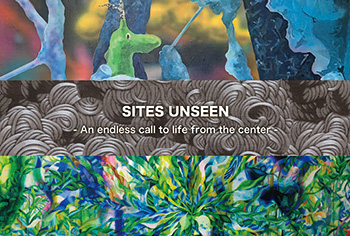
|
SITES UNSEEN - An endless call to life from the center -2021 4.28 - 6.12 |
| ©Kotaro Ono / ©Mizuki Hatakeyama / ©Kazuya Sakamoto |

SITES UNSEEN – An endless call to life from the center –
Venue: nca | nichido contemporary art
Date: 2021/4.28 (wed.) – 6.12 (sat.)
Opening hours: Tue. ~ Sat. 11:00 – 19:00 (Closed on Sunday, Monday and National holidays)
Artists: Kotaro Ono / Kazuya Sakamoto / Mizuki Hatakeyama
nca | nichido contemporary art is pleased to present "SITES UNSEEN –An endless call to life from the center–", a group exhibition featuring work by three artists: Kotaro Ono, Kazuya Sakamoto and Mizuki Hatakeyama. It has been one year since the onset of COVID-19 and we are still steering through uncharted waters.
The overwhelming media coverage and relentless speculation have been triggering fear of the unknown insidiously undermining our mental state. The title of the exhibition, “SITES UNSEEN”, refers to those things that are invisible to the eye. Several philosophers have investigated the relation between “what we see and what we cannot see”. What we see is what we personally experience and is largely affected by our own history, surrounding environment and the process through which we elaborate facts. Biases or the emotional state in a given moment can shape the reality and perception of what we see, and, when we can no longer see, we may experience discomfort and miscommunication. Through a unique perception and an expressive language, the three artists on view give shape to their inner world, unveiling the reality, scenery, temperature, sounds and atmosphere that lie hidden there invisible to the eye. By questioning the future and paving the path to new possibilities, each of these artists has found their way to deal with and process the feelings of oppression and loss the present carries.The exhibition presents works made especially for this occasion.
Strange creatures of different shapes and sizes inhabit Kotaro Ono (1992-)’s work. They sparkle with vitality on a peculiar background that seems to blur the boundaries between reality and fantasy, in a world that does not exist and yet could potentially exist anywhere. Finding his own way to work through the contrast, discomfort and misperceptions experienced towards “the other” when dealing with society at large, Ono has been trying to bring to light his own feelings and true nature by turning reality into a dream world populated by his creatures. As part of his research, Ono turns his experience with the world around him into three-dimensional representations of nature, animals and people, before transferring his creations onto the canvas. Such process provides the artist with the opportunity to create a world shaped by a wide range of emotions, soothing his mind along the way. While Ono, as the main character of this world, freely pulls the strings of his own creations, the energy pouring out from his creatures and nostalgic scenery seems to run wild unleashing our imagination.
Through his interest in growing waterweeds inside home aquariums, Sakamoto has observed similarities between such ecosystems and today’s societies leading him to investigate the inner side of things using plants as his motif. His interest has recently shifted towards the representation of types of waterweeds whose existence tends to pass unnoticed as they grow in full shade, and of other plants whose effort to survive depends on their differently timed life cycle designed to protect them from natural threats. The variety of species minutely represented, multiplying and breeding on the canvas, seems to be a metaphor of the constant changes required of life to thrive. Vividly shining, the energy in Sakamoto’s work imbues the plants, object of his close observation, with vitality, and takes the stage with a strong presence that embraces time, light, shadow, and their continuous cycle.
Mizuki Hatakeyama (1983-)’s approach is based on the artist’s basic rule to bring out the outlines of images he randomly creates through the repetition of wave-like shapes on the canvas. Recording the traces and changes of his actions, Hatakeyama tries to represent the domain of the unconscious by performing aimless movements. The images that come to the front by consciously pursuing the unconscious at times remind us of some scenery, at others they take strange shapes evoking creatures such the Chimera or simple human beings. Through the repetition of the same action, it seems as if the images, born out of an assemble of intricate emotions flowing in different directions, represent the ideal world and heroes the artist has been seeking for. A change in perspective reveals the different faces of these images bestowing us with a new awareness.

